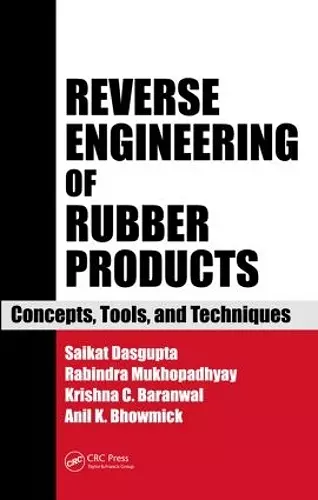Reverse Engineering of Rubber Products
Concepts, Tools, and Techniques
Anil K Bhowmick author Saikat Das Gupta author Rabindra Mukhopadhyay author Krishna C Baranwal author
Format:Hardback
Publisher:Taylor & Francis Inc
Published:19th Sep '13
Currently unavailable, and unfortunately no date known when it will be back
This hardback is available in another edition too:
- Paperback£105.00(9781138075252)

Reverse engineering is widely practiced in the rubber industry. Companies routinely analyze competitors’ products to gather information about specifications or compositions. In a competitive market, introducing new products with better features and at a faster pace is critical for any manufacturer. Reverse Engineering of Rubber Products: Concepts, Tools, and Techniques explains the principles and science behind rubber formulation development by reverse engineering methods. The book describes the tools and analytical techniques used to discover which materials and processes were used to produce a particular vulcanized rubber compound from a combination of raw rubber, chemicals, and pigments.
A Compendium of Chemical, Analytical, and Physical Test Methods
Organized into five chapters, the book first reviews the construction of compounding ingredients and formulations, from elastomers, fillers, and protective agents to vulcanizing chemicals and processing aids. It then discusses chemical and analytical methods, including infrared spectroscopy, thermal analysis, chromatography, and microscopy. It also examines physical test methods for visco-elastic behavior, heat aging, hardness, and other features. A chapter presents important reverse engineering concepts. In addition, the book includes a wide variety of case studies of formula reconstruction, covering large products such as tires and belts as well as smaller products like seals and hoses.
Get Practical Insights on Reverse Engineering from the Book’s Case Studies
Combining scientific principles and practical advice, this book brings together helpful insights on reverse engineering in the rubber industry. It is an invaluable reference for scientists, engineers, and researchers who want to produce comparative benchmark information, discover formulations used throughout the industry, improve product performance, and shorten the product development cycle.
"Rubber is among the most customizable of materials. This fact represents a great opportunity for companies seeking to differentiate their materials and products in the marketplace, and it is the reason that development and competition in the rubber industry hinges so much on materials science. It also presents a great challenge for companies seeking to stay on top of current market trends, since a compound’s make-up is usually a trade secret. The authors of this book are authorities on the subject, and they have done a great service by bringing together this collection of valuable techniques. Readers will appreciate the convenience of having this information in a topic-focused volume, and they will benefit from the decades of experience that the authors bring to the subject."
––Will Mars, CEO, Endurica LLC and editor, Rubber Chemistry and Technology, USA
"Reverse engineering is very important. This is the first text addressing this area and will therefore be of considerable value."
—Brendan Rodgers, ExxonMobil, Texas, USA
ISBN: 9780849373169
Dimensions: unknown
Weight: 793g
357 pages